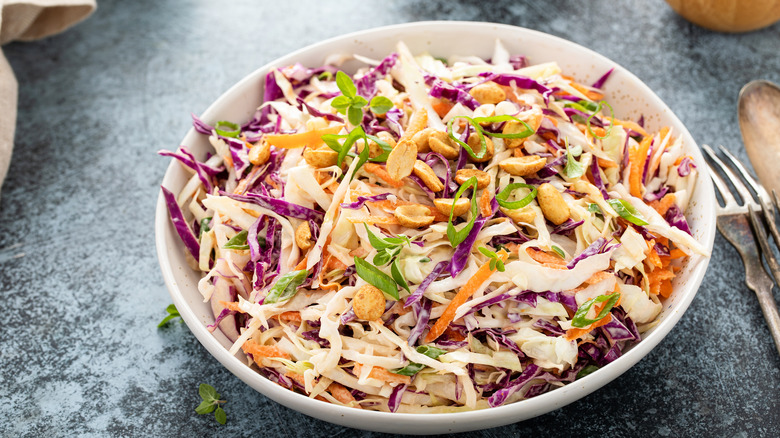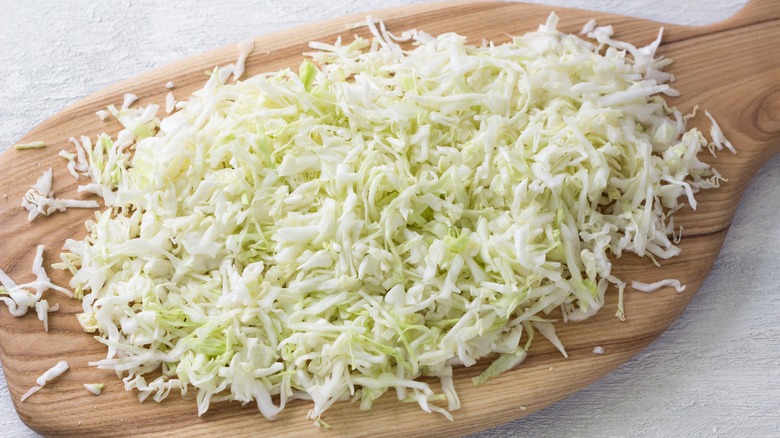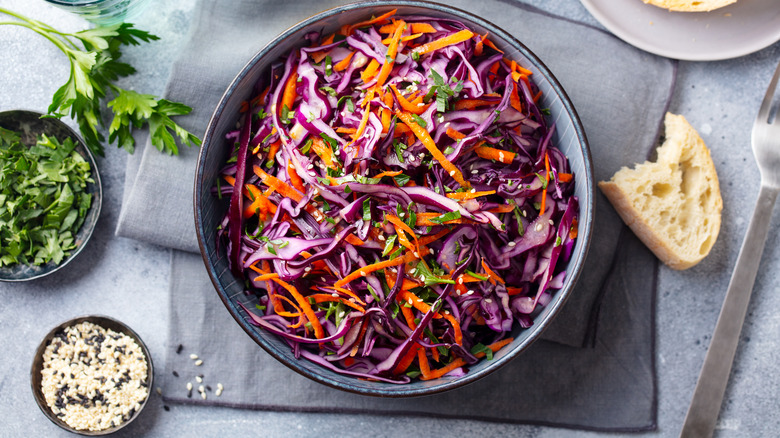The Step You Should Never Skip To Prevent Soggy Coleslaw
Nothing brings a blast of tang and texture to an ordinary sandwich like coleslaw. The backbone of fish tacos, pulled pork sandwiches, and catfish po boys, coleslaw's blend of shredded cabbage and creamy dressing adds a certain excitement to picnics and barbecues. Too often, however, by the time you place coleslaw next to its fellow side dishes, a pool of water has pooled at the bottom of the bowl. All carrot crunch eliminated and cabbage leaves drooping, what was intended to elevate your meal is now a sopping mess.
While many immediately add dressing to their slaw mix, one step can significantly reduce the side's sogginess: salting the cabbage. Cabbage has a high water content. When sliced, it tends to leak, especially when combined with a salty sauce. Salting the shredded cruciferous veg before assembling the slaw helps to keep things fresh and crunchy by removing that excess water before you assemble your dish.
Salting your cabbage maintains coleslaw's crunch
Just as a fried eggplant schnitzel with buttermilk slaw might instruct you to salt the vegetable before cooking, the best coleslaws often follow this same method for preparing the cabbage. Fortunately, salting is one of the easiest cooking steps imaginable.
After shredding your head of cabbage and ensuring it is uniformly sliced, combine the veg with salt (roughly one tablespoon of sea salt per cabbage). Next, place the salted cabbage in a colander to let it drain. After waiting at least an hour, lightly rinse off the cabbage and dry it — a salad spinner will do the trick. You can also dab the cabbage with towels to ensure everything is nice and dry. Besides reducing the sogginess of your slaw, this method also has the bonus of reducing the bitterness in the cruciferous, allowing it to meld with the dressing more pleasantly.
Dress at the last minute for crisper slaw
While many recipes call for a dish to spend some time in the fridge to allow its flavors to develop, coleslaw surprisingly does not require the same length of chill time as, say, a pasta salad might. Adding your dressing to the slaw is obviously an essential step in making the dish. However, doing so too early can also reduce the crunchiness of your coleslaw, gradually wilting the mix. To avoid the common coleslaw mistake of dressing the slaw prematurely, assemble and chill everything for about 15 to 20 minutes at most before serving (enough time to both maximize flavor and minimize sogginess).
If you're taking the coleslaw to a gathering outside your home, this may mean traveling with the dressing and veg stored separately and mixing and chilling the slaw upon your arrival. Although, yes, this may seem a little tedious, holding off on dressing your slaw can significantly improve its texture and make it the star of the potluck.



